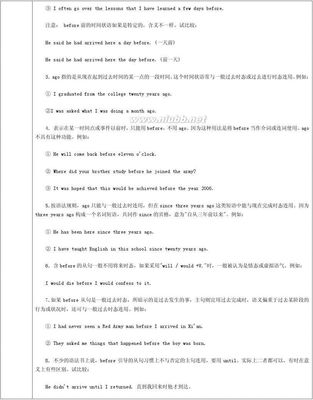过去分词的用法
1.分词的定义
动词的-ed分词即过去分词,是由动词的过去分词构成,一般只有一种形式。
2.过去分词的语法作用
过去分词一方面具有动词的性质,另一方面也相当于一个形容词或副词,在句中可以作表语、定语、状语和补足语。
1) 过去分词作表语,主要表示主语的心理感觉或所处的状态。如:
Don't touch the glass because it is broken. 不要碰那个杯子,它是坏的。
He is quite pleased with the design of the dress. 她很喜欢那礼服的式样。
2)过去分词做定语:
单个的过去分词作定语一般放在名词的前面,相当于一个定语从句。如:
He found that there was a lizard(蜥蜴) stuck(stick) there because anail from outside had been hammered into one of its feet.
The excited people rushed into the building. 激动的人们奔进了大楼。
We need more qualified teachers. 我们需要更多合格的教师。
过去分词短语作定语通常放在被修饰的词后面,相当于一个定语从句。如:
Is there anything planned for tomorrow? 明天有什么活动吗?
The suggestion made by the foreign expert was adopted by themanager. 外国专家提出来的建议被经理采纳了。
过去分词作定语也可用作非限制性定语,前后用逗号隔开。如:
The books, written by lu xun, are popular with many Chinesepeople. 这些书是鲁迅写的,受到了许多中国人民的喜爱。
The meeting,held last month in London, was asuccess. 这次会议获得很大的成功,共有一千个学生出席了。
3) 过去分词做状语:
过去分词和-ing分词作状语一样,也可以表示时间、原因、条件、让步、方式或伴随情况等。
①表时间,相当于一个时间状语从句,有时过去分词前可加连词when或while来强调时间概念。如:
Seen from the top of the hill, the city looked like a big garden.从山顶上看,这个城市就像一个大花园。
Accepted by the party, he decided to devote his life to the causeof the party. 入党以后,他决定献身于党的事业。
②表原因,相当于一个原因状语从句。如:
Crushed/ moved by what his daughter was doing, hethe father put his arms around his little girl,and he beggedher forforgiveness.
Deeply moved by the story, the excited peoplestopped quarrelling with each other. 激动的人们被那个故事深深地感动了,停止了争吵。
Encouraged by the speech, the young people made up their minds totake up the struggle. 受到了讲演的鼓舞,年轻人决定起来从事斗争。
③表条件,相当于一个条件状语从句,有时过去分词前可用if等词。如:
Given another chance, he will do better. 再给他一次机会,他会做得更好。
Compared with your brother, you should make greater efforts tostudy english. 和你哥哥相比,你应该更加努力学习英语。
If heated, water can be turned into steam. 水如果被加热,会变成水蒸气。
④表让步,相当于一个though/although引导的让步状语从句。如:
Exhausted by the running, they went on running after the robber.尽管已经跑得筋疲力尽,他们还是继续追赶着那个强盗。
Laughed at by many people, he continued his study.
尽管被许多人嘲笑,他还是继续他的研究。
⑤表方式或伴随情况。如:
The old man went into the room, supported by hiswife.那个老人在他的妻子的搀扶下走进了房间。
Seated at the table, my father andI were talkingabout my job.我和父亲坐在桌子旁边讨论着我的工作问题。
4)过去分词作补足语:
过去分词可以在see,hear, notice, watch,find, get, have, feel, make, leave,keep等词后与一名词或代词构成复合宾语,用作宾语补语。如:

When will you go to the hospital and have your tooth examined?你什么时候去医院检查你的牙齿?
When you are making a speech, you should speak louder to makeyourself heard. 当你在作报告时,你应该讲响一点使自己被人听清。
当这类句子变成被动语态时,过去分词用作主语补语。如:
One of the glasses was found broken. 有人发现其中一个杯子破了。
They should be kept informed of the situation there.应该让他们知道那儿的形势。
3.过去分词的疑难问题
过去分词作状语时,它的逻辑主语一般必须和句子的主语相一致。如:
When asked why he came here, the boy keptsilent.当那个男孩被问到为何来这里时,他沉默不语。
Born and brought up in the countryside, he was interested inbiology. 由于在农村出生并长大,他对生物很感兴趣。
过去分词作状语时,过去分词表示的动作是句子主语承受的动作,它们之间的关系是被动关系。
Given moreattention, the trees could have grownbetter.如果对这些树多关心一些,它们本来会长得更好。
Faced withdifficulties, we must try to overcomethem.在遇到困难的时候,我们必须设法克服。
如果过去分词的逻辑主语和句子主语不一致,必须使用过去分词的独立主格结构。
独立主格结构http://blog.sina.com.cn/s/blog_53ca7b1b0100m1sb.html
非谓语动词和独立主格结构讲解大全
非谓语动词和独立主格结构讲解大全
分词作表语、定语、状语
 爱华网
爱华网



